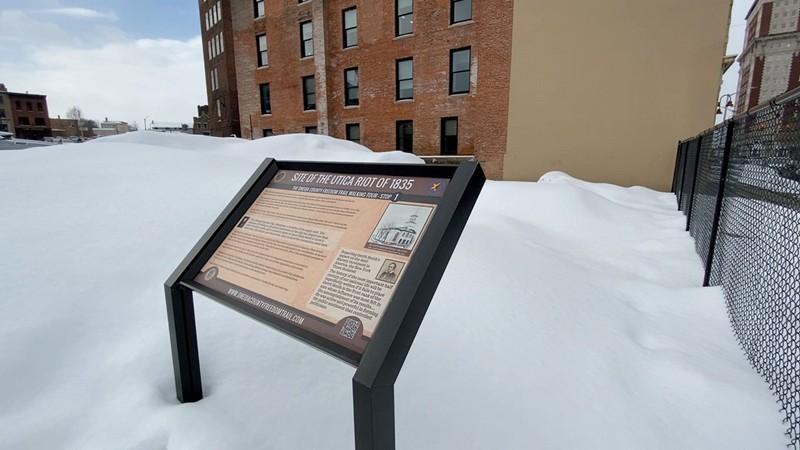Site of the Utica Riot (1835)
Introduction
Text-to-speech Audio
After the state abolished slavery in 1827, many New Yorkers became active in the movement to abolish the institution nationwide. While New Yorkers were not united in their opposition to slavery, there were towns and cities throughout the state that were seen as bastions of abolitionist sentiment. Utica had a particularly active abolitionist community, although they often faced hostility from their pro-slavery neighbors. In 1835, when 600 people gathered in the city to form a statewide anti-slavery society, they were attacked by an anti-abolitionist mob and forced to move to a site out of town.
Images
A simple marker identifies the site of the riot

Gerrit Smith
.jpg)
Backstory and Context
Text-to-speech Audio
Although many beginning students of American history tend to see slavery and racism as uniquely Southern problems, the truth is more complicated. There were many people in the Northern states who opposed slavery, but support for abolition was not universal in the North. In 1835, in Utica, when local abolitionists began planning a meeting to revive the state’s anti-slavery society, many locals were opposed to the idea, believing that abolitionists were radicals whose ideas might trigger a slave revolt.
As the date of the convention approached, local opposition to the gathering grew stronger, even though there were many Uticans who supported the cause. The city was chosen for the convention because it—and upstate as a whole—were important parts of the Underground Railroad. The meeting was originally scheduled to take place in the courthouse, but the public uproar led the Common Council to deny the group permission to meet there. Instead, they arranged to meet at the Second Presbyterian Church.
On October 21, 1835, the day of the convention, hundreds of abolitionists gathered at the church. Among them was Gerrit Smith, a wealthy philanthropist who opposed slavery but did not favor its immediate abolition. At the time, Smith supported returning former slaves to Africa, an idea that was losing ground among abolitionists. Beriah Green, a well-known abolitionist and founder of the Oneida Institute of Science and Industry, was also among the attendees.
Shortly after the meeting began, the gathering was interrupted by a large crowd which assembled outside the church. The mob—estimated to have been roughly 300 people—yelled at the abolitionists and threatened to storm the church. Fearing the mob might turn violent, Smith invited the delegates to reconvene at his estate in Peterboro, 27 miles outside of Utica. The following day, the first meeting of the New York Anti-Slavery Society was held without incident at the Smith estate. The riot in Utica forever changed Smith’s views on slavery; he could no longer support colonization and became a supporter of immediate abolition.
The building where the Utica meeting was held has been home to both the Second Presbyterian Church and later the Bleecker Street Baptist Church. The church was sold in 1887 and was demolished shortly thereafter. The site where the Utica riot took place is now roughly where the Centro Hub transit terminal sits and there are two historic markers in a parking lot that denote the site's significance..
Cite This Entry
Woodham, Rebecca. "Site of the Utica Riot (1835)." Clio: Your Guide to History. February 22, 2022. Accessed April 1, 2025. https://theclio.com/entry/146437
Sources
Utica Anti-Slavery Meeting Site , Freethought Trail . Accessed February 22nd 2022. https://freethought-trail.org/trail-map/location:utica-anti-slavery-meeting-site/.
Patrick, Rashida . Utica Remembers History of Abolition , WRVO. October 30th 2015. Accessed February 22nd 2022. https://www.wrvo.org/regional-coverage/2015-10-30/utica-remembers-history-of-abolition
1835 Anti-Slavery Convention Leads to Utica Riot , Oneida County Freedom Trail . Accessed February 22nd 2022. http://www.oneidacountyfreedomtrail.com/utica-riot-at-1835--convention.html.

